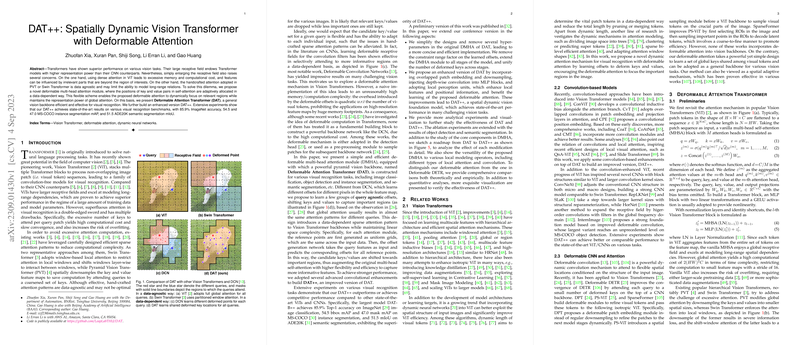An Analytical Overview of DAT++: Spatially Dynamic Vision Transformer with Deformable Attention
The paper "DAT++: Spatially Dynamic Vision Transformer with Deformable Attention" presents a sophisticated exploration into the design and implementation of vision transformers enhanced by deformable attention mechanisms. This work proposes the Deformable Attention Transformer (DAT), revealing significant strides toward adaptive visual recognition networks that excel in frequent transformations inherent in real-world images.
Key Contributions
- Deformable Multi-Head Attention Module: The cornerstone of this paper is the deformable multi-head attention (DMHA) module. Unlike traditional attention methods, DMHA adaptively allocates key and value pairs in a data-dependent manner, enhancing representation while mitigating excessive computational costs typical in vision transformers (ViTs).
- Enhanced Model Performance: Through incorporating deformable attention, the model achieves substantial performance improvements across various benchmarks: 85.9% ImageNet accuracy, 54.5 mAP in MS-COCO instance segmentation, and 51.5 mIoU on ADE20K semantic segmentation.
- Hierarchical Architecture: The proposed architecture withstands variants of vision tasks by processing images hierarchically. This structure enables efficient learning of multiscale features across different stages of the model—reminiscent of traditional convolutional neural networks (CNNs) yet enhanced with the transformer’s large receptive field.
- Innovative Experiments: Extensive quantitative analyses underscore the robustness of DAT++, affirming its competitive or superior performance relative to existing ViTs and CNNs.
Technical Insights
- Offset Learning: By learning query agnostic offsets, the DMHA dynamically focuses on key positions in the visual field, substantially reducing the spatial redundancy often observed in traditional attention patterns.
- Efficient Design Choices: The authors implemented several design simplifications and performance enhancers in DAT++, like overlapped patch embedding and convolutional enhancements in MLP blocks, contributing to the model's efficiency and effectiveness.
- Comprehensive Ablation Studies: Through various ablation studies, the paper presents a compelling case for the incorporation of deformable attention in visual backbones. The analyses detail the impact of offset ranges, attention configurations, and relative position encodings on model performance.
Practical Implications
The advancements introduced with DAT++ offer a pragmatic pathway toward developing dynamic neural networks capable of adapting to complex visual environments. These improvements promise potential applications in fields requiring high accuracy and efficiency, such as real-time object detection and autonomous systems.
Theoretical Implications
The theoretic underpinning of dynamically adjusting key positions paves the way for further exploration into deformable computational structures within transformers. This paradigm shift from rigid attention patterns to adaptable configurations signifies a new direction in the design of neural architectures.
Future Trajectories in AI
- Scalability and Adaptation: Future work may entail scaling the deformable attention mechanism to accommodate broader datasets or adapting it for emerging vision tasks, ensuring model versatility and robustness.
- Integration with Other Modalities: Extending deformable attention to multimodal learning scenarios could unlock new frontiers in AI, facilitating more nuanced perception and reasoning tasks.
In conclusion, this paper offers significant contributions to the evolving landscape of vision transformers, setting a foundation for continued advancements in spatially dynamic attention mechanisms. Its impact on the field is substantial, presenting both theoretical and practical avenues for enhancing the capabilities of neural networks across a myriad of applications.
